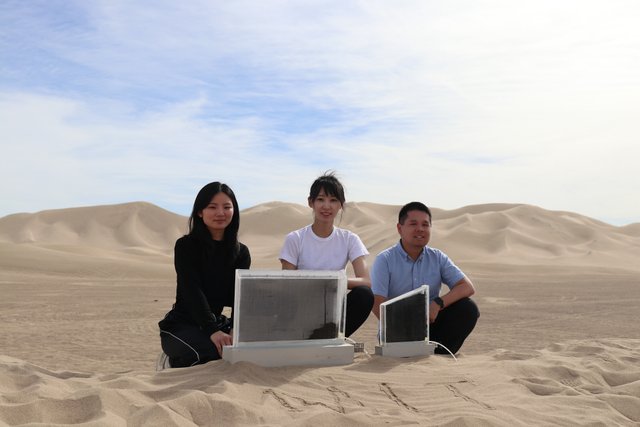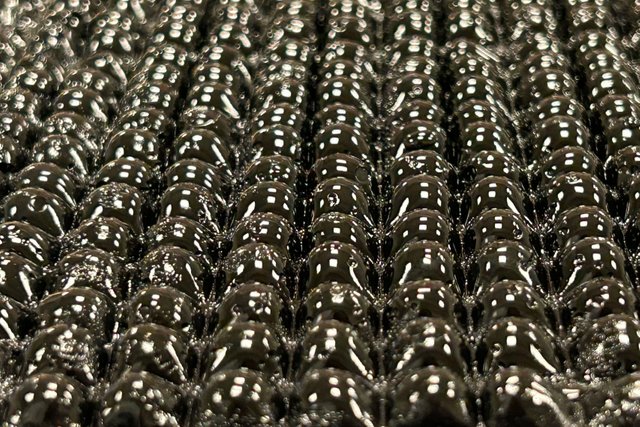Window-sized passive device extracts drinking water from the air without energy/Dispositivo pasivo del tamaño de una ventana extrae agua potable del aire sin necesidad de energía

Source
That human beings are, in general, quite slovenly and careless with the environment around us is beyond doubt. Especially since the Industrial Revolution, we have been overexploiting, polluting, and fouling the air, sea, and land, to the point we are at today. But it is also true that we are capable of finding solutions to all the problems we create when we have enough pressure, as in the invention we are discussing today to alleviate the shortage of drinking water.
Que los seres humanos somos, en general, bastante marranos y descuidados con el entorno que nos rodea es algo que no ofrece la menor duda. Sobre todo a partir de la revolución industrial hemos estado sobreexplotando, contaminando y enguarrando el aire, el mar y la tierra, hasta llegar al punto en que nos encontramos. Pero también es cierto que somos capaces de encontrar soluciones a todos los problemas que creamos cuando tenemos la presión suficiente, como en el invento que hoy nos ocupa para paliar la escasez de agua potable.
A team of engineers at the Massachusetts Institute of Technology (MIT) has developed an innovative, window-sized passive device that can extract drinking water directly from the air, even in extremely dry environments, without the need for electricity, batteries, or solar panels. Furthermore, the system is designed to operate completely autonomously, both during the day and at night, using advanced materials and simple physical principles.
Un equipo de Ingenieros del Massachussets Institute of Technology (MIT) han desarrollado un innovador dispositivo pasivo con el tamaño de una ventana, que puede extraer agua potable directamente del aire, incluso en ambientes extremadamente secos, sin necesidad de electricidad, baterías ni paneles solares. Además el sistema está diseñado para funcionar de manera completamente autónoma, tanto durante el día como durante la noche, utilizando materiales avanzados y principios físicos simples.

Source
The developed device consists of a vertical panel, roughly the size of a window, enclosed in a glass chamber with a cooling layer. The core is formed by a black, bubble-like hydrogel, which maximizes the surface area in contact with the air and improves water vapor absorption. During the night, the hydrogel absorbs water vapor from the air, taking advantage of the higher relative humidity at night. During the day, with the heat of the sun, the hydrogel releases the vapor, which condenses on the cooled glass surface and is collected as drinking water through a tube.
El dispositivo desarrollado consiste en un panel vertical, aproximadamente del tamaño de una ventana, encerrado en una cámara de vidrio con una capa refrigerante. El núcleo está formado por un hidrogel negro con forma de burbujas, que maximiza la superficie de contacto con el aire y mejora la absorción del vapor de agua. Durante la noche el hidrogel absorbe el vapor de agua del aire, aprovechando la mayor humedad relativa nocturna y por el día con el calor del sol, el hidrogel libera el vapor que condensa en la superficie enfriada del vidrio y es recolectado como agua potable a través de un tubo.
Hydrogel is a material composed primarily of water and polymers, and has the ability to retain large amounts of liquid. The material used in this device also contains glycerol, which stabilizes salts and prevents them from leaching into the water, ensuring that the collected water is safe for human consumption without the need for additional filtration. The device has already been tested in real-world conditions, and its performance has outperformed other passive systems and some active ones in dry climates.
El hidrogel es un material que se compone principalmente de agua y polímeros, y tiene la capacidad de retener grandes cantidades de líquido, el utilizado en este dispositivo además contiene glicerol, que estabiliza las sales y evita que se filtren al agua, garantizando que el agua recolectada sea segura para el consumo humano sin necesidad de filtrado adicional. El dispositivo ya ha sido probado en condiciones reales y su rendimiento ha superado a otros sistemas pasivos y algunos activos en climas secos.

Source
It was tested for seven days in Death Valley, California, under extremely arid conditions, ranging from 21% to 88% relative humidity. In this trial, between 57 mL and 161 mL were collected per day per half-square-meter panel, depending on the humidity. In the driest conditions, it still remained effective, outperforming other passive or even some active designs. Objectively, it doesn't seem like much water, as it only collects a glassful per day, but MIT scientists are working to improve the absorption speed and efficiency of the hydrogel to increase water production.
Se probó durante 7 días en Death Valley, en California en condiciones extremadamente áridas, entre un 21 % y 88 % de humedad relativa. En este ensayo se obtuvieron entre 57 mL y 161 mL por día por panel de medio metro cuadrado, dependiendo de la humedad. En las condiciones más secas, aún conservó eficacia, superando a otros diseños pasivos o incluso algunos activos. Objetivamente no parece mucha agua ya que apenas recolecta un vaso por día, pero los científicos del MIT están trabajando en mejorar la velocidad de absorción y la eficiencia del hidrogel para aumentar la producción de agua.
Although it's still an early prototype, the interesting thing is that it works without electricity or moving parts, which avoids a ton of problems. The technology is scalable, so theoretically, dozens of these panels could be installed in parallel on a facade or rooftop. It's anticipated that in the future, batteries of these panels could be installed to supply entire homes in areas with water shortages, but where it can be truly useful is in regions without infrastructure, in emergencies, or as a supplement to isolated homes; even a small amount of water can make a difference.
Aunque de momento es un prototipo en fase temprana, lo interesante es que funciona sin electricidad ni piezas móviles, lo cual evita montones de problemas. La tecnología es escalable por lo que teóricamente se podría instalar decenas de estos paneles en paralelo en una fachada o azotea. Se prevé que en el futuro puedan instalarse baterías de estos paneles para abastecer hogares completos en zonas donde tengan escasez de agua, pero donde puede ser realmente útil es en regiones sin infraestructura, en emergencias, o como complemento en viviendas aisladas, aunque sea poca cantidad de agua puede marcar la diferencia.
More information/Más información
https://news.mit.edu/2025/window-sized-device-taps-air-safe-drinking-water-0611